The download of Google Earth 5.0 to Mac OS X is painless, as expected. Ocean lovers will be delighted with the improved seafloor topography. It’s something DSN has been anticipating for a long time now. Last year I ran this story describing the need for the new ocean layer and some of the science behind it. In a way, that story established a baseline for product quality that doesn’t exist anymore. Next time you open Google Earth you’ll see the new seafloor product, whether you download 5.0 or not. It’s like you’re working in the cubicle of a George Orwell novel and suddenly the old seafloor never existed.
Undoubtedly, the big question for those who remember making seafloor maps with the old product will be, how much better is the new seafloor bathymetry compared to the old one? Thanks to the old blog entry, we have some image data for comparison. The improvement is dramatic.
Monterey Bay, California
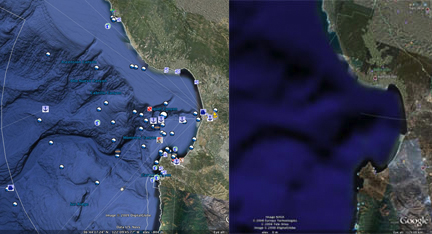
Saba Bank, Netherlands Antilles
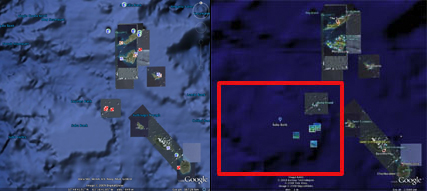
The elevation model in the new Google Earth is “negative friendly”. That is, you can view the Earth from below sea level. Dive in. Explore. The new seafloor layer is a blended product of multibeam echosounder technology (30-200 m resolution) and satellite derived depth estimates based sea surface height and gravity (~4 km resolution). The images above are ~100 km square. The dots in the images to the left link to multimedia content, with narrations by Sylvia Earle and others.
The good news for those of us who occasionally make maps for a living (ahem) is that there are still a few things missing from Google Earth’s ocean. There’s no obvious tool for vertical exaggeration, for example. This may be something they’re saving for Google Earth Pro. I’ll let you know what I find. For now, there’s almost too much to explore. Please, tell us what you find interesting. The comments are open.


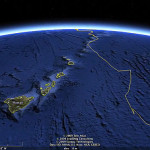
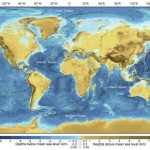

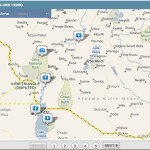
This is great and a huge step forward, but it’s still not high-res enough for my liking. But, I suppose I’m never satisfied!
Once you’ve had LIDAR and multibeam you can never go back, eh? ;)
Vertical exaggeration has always been available under “Tools | Options | 3D View”.
Thanks, Joe. That’s good to know. I’ll give that a try on some of these seamount features. I have found that 2x, 5x, and even 10x exaggeration can be useful when viewing seafloor topography in other visualization software.
A friend of mine has been doing research on the Ninetyeast Ridge. It’s really cool to be able to see what she’s been talking about all this time. Thanks for letting us know about the update!
You’re welcome, Aaron. Ninety-East Ridge is new to me, but I found it quickly in Google Earth using the coordinates and the GEBCO Geographic Names .kml file
This brings up 2 good points, (1) to view lat/lon parallels click View -> Grid, (2) to view place names like “Ninety-East Ridge” the GEBCO Geographic Names .kml file is still a necessity. This data layer is described in the DSN story “Pimp Your Google Earth“
Vertical exaggeration in 5.0 (.5-3x) is located under preferences -> 3D View -> terrain quality